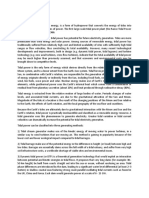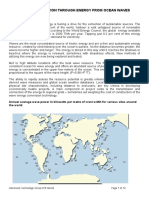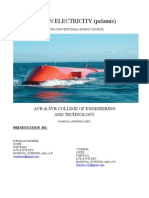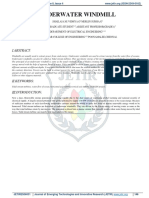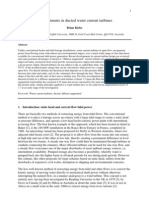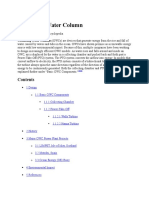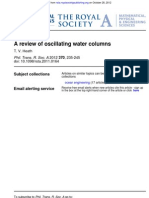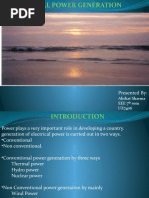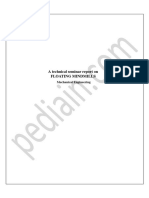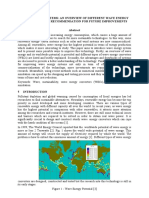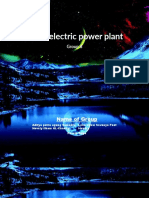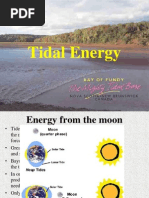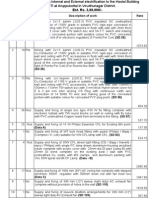Tidal Stream Generator: Similarity To Wind Turbines
Tidal Stream Generator: Similarity To Wind Turbines
Uploaded by
Satyanag VenishettyCopyright:
Available Formats
Tidal Stream Generator: Similarity To Wind Turbines
Tidal Stream Generator: Similarity To Wind Turbines
Uploaded by
Satyanag VenishettyOriginal Title
Copyright
Available Formats
Share this document
Did you find this document useful?
Is this content inappropriate?
Copyright:
Available Formats
Tidal Stream Generator: Similarity To Wind Turbines
Tidal Stream Generator: Similarity To Wind Turbines
Uploaded by
Satyanag VenishettyCopyright:
Available Formats
Tidal stream generator
Tidal stream generator
A tidal stream generator, often referred to as a tidal energy converter (TEC) is a machine that extracts energy from moving masses of water, in particular tides, although the term is often used in reference to machines designed to extract energy from run of river or tidal estuarine sites. Certain types of these machines function very much like underwater wind turbines, and are thus often referred to as tidal turbines. Tidal stream generators are the cheapest and the least ecologically damaging among the three main forms of tidal power generation.[1]
Artist's impression of tidal turbines on a different type of support structure.
Similarity to wind turbines
Tidal stream generators draw energy from water currents in much the same way as wind turbines draw energy from air currents. As a relatively new technology, though first conceived in the 1970s during the oil crisis,[2] the potential for power generation by an individual tidal turbine can be greater than that of similarly rated wind energy turbine. The higher density of water relative to air (water is about 800 times the density of air) means that a single Most tidal turbines resemble a wind turbine, most generator can provide significant power at low tidal flow velocities commonly the HAWT-type (centre). compared with similar wind speed.[3] Given that power varies with the density of medium and the cube of velocity, it is simple to see that water speeds of nearly one-tenth of the speed of wind provide the same power for the same size of turbine system; however this limits the application in practice to places where the tide moves at speeds of at least 2knots (1m/s) even close to neap tides. Furthermore, at higher speeds in a flow between 2 to 3metres per second in seawater a tidal turbine can typically access four times as much energy per rotor swept area as a similarly rated power wind turbine.
Types of tidal stream generators
Since tidal stream generators are an immature technology, no standard technology has yet emerged as the clear winner, but a large variety of designs are being experimented with, some very close to large scale deployment. Several prototypes have shown promise with many companies making bold claims, some of which are yet to be independently verified, but they have not operated commercially for extended periods to establish performances and rates of return on investments. The European Marine Energy Centre[4] categorises them under four heads although a number of other approaches are also being tried.
Tidal stream generator
Axial turbines
These are close in concept to traditional windmills operating under the sea and have the most prototypes currently operating. These include: The AR-1000, a 1MW tidal turbine developed by Atlantis Resources Corporation which was successfully deployed and commissioned at the EMEC facility during the summer of 2011. The AR series turbines are commercial scale Horizontal Axis Turbines designed for open ocean deployment in the harshest environments on the planet. AR turbines feature a single rotor set with highly efficient fixed pitch blades. The AR turbine is rotated as required with each tidal exchange. This is done in the slack period between tides and fixed in place for the optimal heading for the next tide. AR turbines are rated at 1MW @ 2.65m/s of water flow velocity.
Evopod - A semi-submerged floating approach tested in Strangford Lough.
Further information about Atlantis Resources Corporation can be found here. [5] Kvalsund, south of Hammerfest, Norway.[6] Although still a prototype, a turbine with a reported capacity of 300kW was connected to the grid on 13 November 2003. A 300kW Periodflow marine current propeller type turbine Seaflow was installed by Marine Current Turbines off the coast of Lynmouth, Devon, England, in 2003.[7] The 11m diameter turbine generator was fitted to a steel pile which was driven into the seabed. As a prototype, it was connected to a dump load, not to the grid. Since April 2007 Verdant Power[8] has been running a prototype project in the East River between Queens and Roosevelt Island in New York City; it was the first major tidal-power project in the United States.[9] The strong currents pose challenges to the design: the blades of the 2006 and 2007 prototypes broke off, and new reinforced turbines were installed in September 2008.[10][11] Following the Seaflow trial, a full-size prototype, called SeaGen, was installed by Marine Current Turbines in Strangford Lough in Northern Ireland in April 2008. The turbine began to generate at full power of just over 1.2MW in December 2008[12] and is reported to have fed 150kW into the grid for the first time on 17 July 2008, and has now contributed more than a gigawatt hour to consumers in Northern Ireland.[13] It is currently the only commercial scale device to have been installed anywhere in the world.[14] SeaGen is made up of two axial flow rotors, each of which drive a generator. The turbines are capable of generating electricity on both the ebb and flood tides because the rotor blades can pitch through 180.[15] OpenHydro,[16] an Irish company exploiting the Open-Centre Turbine developed in the U.S., has a prototype being tested at the European Marine Energy Centre (EMEC), in Orkney, Scotland. A prototype semi-submerged floating tethered tidal turbine called Evopod has been tested since June 2008[17] in Strangford Lough, Northern Ireland at 1/10 scale. The company developing it is called Ocean Flow Energy Ltd,[18] and they are based in the UK. The advanced hull form maintains optimum heading into the tidal stream and it is designed to operate in the peak flow of the water column. Tenax Energy of Australia is proposing to put 450 turbines off the coast of the Australian city Darwin, in the Clarence Strait. The turbines feature a rotor section that is approximately 15metres in diameter with a gravity base which is slighter larger than this to support the structure. The turbines will operate in deep water well below shipping channels. Each turbine is forecast to produce energy for between 300 and 400 homes.[19]
Tidal stream generator Tidalstream, a UK-based company, has commissioned a scaled-down Triton 3 turbine in the Thames, see picture on the right, and photographs maintained on their website [20].[21] It can be floated out to site, installed without cranes, jack-ups or divers, and then ballasted into operating position. At full scale the Triton 3 in 30-50m deep water has a 3MW capacity, and the Triton 6 in 60-80m water has a capacity of up to 10MW, depending on the flow. Both platforms have man-access capability both in the operating position and in the float-out maintenance position.
Vertical and horizontal axis crossflow turbines
Invented by Georges Darreius in 1923 and Patented in 1929, these turbines that can be deployed either vertically or horizontally. The Gorlov turbine[22] is a variant of the Darrieus design featuring a helical design which is being commercially piloted on a large scale in S. Korea,[23] starting with a 1MW plant that started in May 2009[24] and expanding to 90MW by 2013. Neptune Renewable Energy has developed Proteus[25] a shrouded vertical axis turbine which can be used to form an array in mainly estuarine conditions. The Musgrove vertical Axis Wind Turbine with vertical self starting free hinged aerodynamic blades is probably the inspiration for the this turbine. In late April 2008, Ocean Renewable Power Company, LLC (ORPC) [26] successfully completed the testing of its proprietary turbine-generator unit (TGU) prototype at ORPC's Cobscook Bay and Western Passage tidal sites near Eastport, Maine.[27] The TGU is the core of the OCGen technology and utilizes advanced design cross-flow (ADCF) turbines to drive a permanent magnet generator located between the turbines and mounted on the same shaft. ORPC has developed TGU designs that can be used for generating power from river, tidal and deep water ocean currents. Trials in the Strait of Messina, Italy, started in 2001 of the Kobold concept.[28]
Flow augmented turbines
Using flow augmentation measures, for example a duct or shroud, the incident power available to a turbine can be increased. The most common example uses a shroud to increase the flow rate through the turbine, which can be of either the axial or crossflow type. The Australian company Tidal Energy Pty Ltd undertook successful commercial trials of efficient shrouded tidal turbines on the Gold Coast, Queensland in 2002. Tidal Energy has commenced a rollout of their shrouded turbine for a remote Australian community in northern Australia where there are some of the fastest flows ever recorded (11m/s, 21knots) two small turbines will provide 3.5MW. Another larger 5meter diameter turbine, capable of 800kW in 4m/s of flow, is planned for deployment as a tidal powered desalination showcase near Brisbane Australia in October 2008.
Oscillating devices
Oscillating devices do not have a rotating component, instead making use of aerofoil sections which are pushed sideways by the flow. Oscillating stream power extraction was proven with the omni- or bi-directional Wing'd Pump windmill.[29] During 2003 a 150kW oscillating hydroplane device, the Stingray, was tested off the Scottish coast.[30] The Stingray uses hydrofoils to create oscillation, which allows it to create hydraulic power. This hydraulic power is then used to power a hydraulic motor, which then turns a generator.[2] Pulse Tidal operate an oscillating hydrofoil device in the Humber estuary.[31] Having secured funding from the EU, they are developing a commercial scale device to be commissioned 2012.[32] The bioSTREAM tidal power conversion system, uses the biomimicry of swimming species, such as shark, tuna, and mackerel using their highly efficient Thunniform mode propulsion. It is produced by Australian company BioPower Systems. A 2kW prototype relying on the use of two oscillating hydrofoils in a tandem configuration has been developed at Laval University and tested successfully near Quebec City, Canada, in 2009. A hydrodynamic efficiency of 40% has
Tidal stream generator been achieved during the field tests.[33]
Venturi effect
Venturi effect devices use a shroud or duct in order to generate a pressure differential which is used to run a secondary hydraulic circuit which is used to generate power. A device, the Hydro Venturi, is to be tested in San Francisco Bay.[34]
Commercial plans
RWE's npower announced that it is in partnership with Marine Current Turbines to build a tidal farm of SeaGen turbines off the coast of Anglesey in Wales,[35] near the Skerries.[36] In November 2007, British company Lunar Energy announced that, in conjunction with E.ON, they would be building the world's first deep-sea tidal energy farm off the coast of Pembrokshire in Wales. It will provide electricity for 5,000 homes. Eight underwater turbines, each 25metres long and 15metres high, are to be installed on the sea bottom off St David's peninsula. Construction is due to start in the summer of 2008 and the proposed tidal energy turbines, described as "a wind farm under the sea", should be operational by 2010. British Columbia Tidal Energy Corp. plans to deploy at least three 1.2MW turbines in the Campbell River or in the surrounding coastline of British Columbia by 2009.[37] An organisation named Alderney Renewable Energy Ltd [38] is planning to use tidal turbines to extract power from the notoriously strong tidal races around Alderney in the Channel Islands. It is estimated that up to 3GW could be extracted. This would not only supply the island's needs but also leave a considerable surplus for export.[39] Nova Scotia Power has selected OpenHydro's turbine for a tidal energy demonstration project in the Bay of Fundy, Nova Scotia, Canada and Alderney Renewable Energy Ltd for the supply of tidal turbines in the Channel Islands. Open Hydro [40] Pulse Tidal [41] are designing a commercial device with seven other companies who are expert in their fields.[42] The consortium was awarded an 8 million EU grant to develop the first device, which will be deployed in 2012 and generate enough power for 1,000 homes. Pulse is in a good position to scale up production because the supply chain is already in place. ScottishPower Renewables [43] are planning to deploy ten 1MW HS1000 devices designed by Hammerfest Strom [44] in the Sound of Islay.[45]
Energy calculations
Turbine power
Tidal energy converters can have varying modes of operating and therefore varying power output. If the power coefficient of the device " " is known, the equation below can be used to determine the power output of the hydrodynamic subsystem of the machine. This available power cannot exceed that imposed by the Betz limit on the power coefficient, although this can be circumvented to some degree by placing a turbine in a shroud or duct. This works, in essence, by forcing water which would not have flowed through the turbine through the rotor disk. In these situations it is the frontal area of the duct, rather than the turbine, which is used in calculating the power coefficient and therefore the Betz limit still applies to the device as a whole. The energy available from these kinetic systems can be expressed as:
where:
Tidal stream generator = the turbine power coefficient P = the power generated (in watts) = the density of the water (seawater is 1027 kg/m) A = the sweep area of the turbine (in m) V = the velocity of the flow Relative to an open turbine in free stream, ducted turbines are capable of as much as 3 to 4 times the power of the same turbine rotor in open flow. .[46]
Resource assessment
While initial assessments of the available energy in a channel have focus on calculations using the kinetic energy flux model, the limitations of tidal power generation are significantly more complicated. For example, the maximum physical possible energy extraction from a strait connecting two large basins is given to within 10% by:[47][48]
where = the density of the water (seawater is 1027 kg/m) g = gravitational acceleration (9.80665 m/s2) = maximum differential water surface elevation across the channel = maximum volumetric flow rate though the channel.
Potential sites
As with wind power, selection of location is critical for the tidal turbine. Tidal stream systems need to be located in areas with fast currents where natural flows are concentrated between obstructions, for example at the entrances to bays and rivers, around rocky points, headlands, or between islands or other land masses. The following potential sites are under serious consideration: Pembrokeshire in Wales[49] River Severn between Wales and England[50] Cook Strait in New Zealand[51] Kaipara Harbour in New Zealand[52] Bay of Fundy[53] in Canada. East River[54][55] in the USA Golden Gate in the San Francisco Bay[56] Piscataqua River in New Hampshire[57] The Race of Alderney and The Swinge in the Channel Islands[39] The Sound of Islay, between Islay and Jura in Scotland[58] Pentland Firth between Caithness and the Orkney Islands, Scotland Humboldt County, California in the United States Columbia River, Oregon in the United States
Modern advances in turbine technology may eventually see large amounts of power generated from the ocean, especially tidal currents using the tidal stream designs but also from the major thermal current systems such as the Gulf Stream, which is covered by the more general term marine current power. Tidal stream turbines may be arrayed in high-velocity areas where natural tidal current flows are concentrated such as the west and east coasts of Canada, the Strait of Gibraltar, the Bosporus, and numerous sites in Southeast Asia and Australia. Such flows occur almost anywhere where there are entrances to bays and rivers, or between land masses where water currents are concentrated.
Tidal stream generator
Environmental impacts
Very little direct research or observation of tidal stream systems exists. Most direct observations consist of releasing tagged fish upstream of the device(s) and direct observation of mortality or impact on the fish. One study of the Roosevelt Island Tidal Energy (RITE, Verdant Power) project in the East River (New York City), utilized 24 split beam hydroacoustic sensors (scientific echosounder) to detect and track the movement of fish both upstream and downstream of each of six turbines. The results suggested (1) very few fish using this portion of the river, (2) those fish which did use this area were not using the portion of the river which would subject them to blade strikes, and (3) no evidence of fish traveling through blade areas. Work is currently being conducted by the Northwest National Marine Renewable Energy Center (NNMREC[59])to explore and establish tools and protocols for assessment of physical and biological conditions and monitor environmental changes associated with tidal energy development.
References
[1] "Tidal power" (http:/ / www. esru. strath. ac. uk/ EandE/ Web_sites/ 01-02/ RE_info/ Tidal Power. htm#streams). . Retrieved 1 November 2010. [2] Jones, Anthony T., and Adam Westwood. "Power from the oceans: wind energy industries are growing, and as we look for alternative power sources, the growth potential is through the roof. Two industry watchers take a look at generating energy from wind and wave action and the potential to alter." The Futurist 39.1 (2005): 37(5). GALE Expanded Academic ASAP. Web. 8 October 2009. [3] "Surfing Energy's New Wave" Time International 16 June 2003: 52+. http:/ / www. time. com/ time/ magazine/ article/ 0,9171,457348,00. html [4] EMEC. "Tidal Energy Devices" (http:/ / www. emec. org. uk/ tidal_devices. htm). . Retrieved 5 October 2008. [5] http:/ / www. atlantisresourcescorporation. com/ [6] First power station to harness Moon opens - September 22, 2003 - New Scientist (http:/ / www. newscientist. com/ article. ns?id=dn4188) [7] REUK: "Read about the first open-sea tidal turbine generator off Lynmouth, Devon" (http:/ / www. reuk. co. uk/ Worlds-First-Open-Sea-Tidal-Turbine. htm) [8] Verdant Power (http:/ / www. verdantpower. com/ what-initiative) [9] MIT Technology Review, April 2007 (http:/ / www. technologyreview. com/ Energy/ 18567/ ). Retrieved August 24, 2008. [10] Robin Shulman (September 20, 2008). "N.Y. Tests Turbines to Produce Power. City Taps Current Of the East River" (http:/ / www. washingtonpost. com/ wp-dyn/ content/ article/ 2008/ 09/ 19/ AR2008091903729. html). Washington Post. . Retrieved 2008-10-09. [11] Kate Galbraith (September 22, 2008). "Power From the Restless Sea Stirs the Imagination" (http:/ / www. nytimes. com/ 2008/ 09/ 23/ business/ 23tidal. html?em). New York Times. . Retrieved 2008-10-09. [12] http:/ / www. marineturbines. com/ 3/ news/ [13] First connection to the grid (http:/ / www. marineturbines. com/ 3/ news/ / ) [14] Sea Generation Tidal Turbine (http:/ / www. marineturbines. com/ 18/ projects/ 19/ seagen/ ) [15] Marine Current Turbines. "Technology." Marine Current Turbines. Marine Current Turbines, n.d. Web. 5 October 2009. <http://www.marineturbines.com/21/ technology/>. [16] OpenHydro (http:/ / www. openhydro. com/ ) [17] (http:/ / www. oceanflowenergy. com/ news-details. aspx?id=6) Ocean Flow Energy Ltd announce the start of their testing in Strangford Lough [18] Ocean Flow Energy company website (http:/ / www. oceanflowenergy. com/ ) [19] Nigel Adlam (2010-01-29). "Tidal power project could run all homes" (http:/ / www. ntnews. com. au/ article/ 2010/ 01/ 29/ 119431_ntnews. html). Northern Territory News. . Retrieved 2010-06-06. [20] http:/ / www. tidalstream. co. uk [21] (http:/ / www. tidalstream. co. uk) [22] Gorlov Turbine (http:/ / www. gcktechnology. com/ ) [23] Gorlov Turbines in Koreas (http:/ / www. worldchanging. com/ archives/ 002383. html) [24] "South Korea starts up, to expand 1-MW Jindo Uldolmok tidal project" (http:/ / www. hydroworld. com/ index/ display/ article-display/ 2336952618/ articles/ hrhrw/ hydroindustrynews/ ocean-tidal-streampower/ south-korea_starts. html). Hydro World. 2009. . [25] Proteus (http:/ / www. neptunerenewableenergy. com/ ) [26] http:/ / www. oceanrenewablepower. com [27] "Tide is slowly rising in interest in ocean power" (http:/ / www. masshightech. com/ stories/ 2008/ 07/ 28/ weekly9-Tide-is-slowly-rising-in-interest-in-ocean-power. html/ ). Mass High Tech: The Journal of New England Technology. August 1, 2008. . Retrieved 2008-10-11. [28] A.D.A.Group (http:/ / www. dpa. unina. it/ adag/ eng/ renewable_energy. html)
Tidal stream generator
[29] Wing'd Pump Windmill (http:/ / econologica. org/ watermill. htm) [30] Stingray (http:/ / www. engb. com/ ) [31] BBC Look North "A tidal power project in the Humber has generated its first batch of electricity" (http:/ / www. youtube. com/ watch?v=z07OV0d9NS4) [32] EU Grant reported by The Engineer (http:/ / www. theengineer. co. uk/ pulse-tidal-receives-eu-grant/ 1000213. article) [33] HAO turbine (http:/ / hydrolienne. fsg. ulaval. ca/ en) [34] San Francisco Bay Guardian News (http:/ / www. sfbg. com/ 38/ 43/ news_tidal. html) [35] "RWE plans 10.5MW sea current power plant off Welsh coast - Forbes.com" (http:/ / www. forbes. com/ markets/ feeds/ afx/ 2008/ 02/ 07/ afx4626015. html). . [36] RWE npower renewables Sites > Projects in Development > Marine > Skerries > The Proposal : Anglesey Skerries Tidal Stream Array (http:/ / www. rwe. com/ web/ cms/ en/ 309778/ rwe-npower-renewables/ sites/ projects-in-development/ marine/ skerries/ the-proposal/ ). Retrieved February 26, 2010. [37] Tidal Power Coming to West Coast of Canada (http:/ / www. alternative-energy-news. info/ press/ tidal-power-west-coast-canada/ ) [38] http:/ / www. are. gb. com/ index. php [39] Alderney Renewable Energy Ltd (http:/ / www. are. gb. com/ index. php) [40] http:/ / www. openhydro. com [41] http:/ / www. pulsetidal. com [42] Pulse Press Release: Consortium members signed up with EU Grant: Bosch Rexroth will provide the hydraulics; Herbosch Kiere the installation; DNV the certification; IT Power the engineering; Niestern Sander the construction; the Fraunhofer IWES the control systems; and Gurit the composites (http:/ / www. pulsegeneration. co. uk/ ?q=node/ 54) [43] http:/ / www. scottishpowerrenewables. com [44] http:/ / www. hammerfeststrom. com [45] Islay Energy Trust (http:/ / www. islayenergytrust. org. uk) [46] http:/ / www. cyberiad. net/ library/ pdf/ bk_tidal_paper25apr06. pdf tidal paper on cyberiad.net [47] Atwater, J.F., Lawrence, G.A. (2008) Limitations on Tidal Power Generation in a Channel, Proceedings of the 10th World Renewable Energy Congress. (pp 947952) [48] Garrett, C. and Cummins, P. (2005). "The power potential of tidal currents in channels." Proceedings of the Royal Society A: Mathematical, Physical and Engineering Sciences, Vol. 461, London. The Royal Society, 25632572 [49] Builder & Engineer - Pembrokeshire tidal barrage moves forward (http:/ / www. builderandengineer. co. uk/ news/ general/ pembrokeshire-tidal-barrage-moves-forward-934. html) [50] Severn balancing act (http:/ / www. walesonline. co. uk/ news/ politics-news/ tm_headline=severn-balancing-act-hain& method=full& objectid=19718602& siteid=50082-name_page. html) [51] NZ: Chance to turn the tide of power supply | EnergyBulletin.net | Peak Oil News Clearinghouse (http:/ / www. energybulletin. net/ 6046. html) [52] "Harnessing the power of the sea" (http:/ / www. contrafedpublishing. co. nz/ Energy+ NZ/ Harnessing+ the+ power+ of+ the+ sea. html). Energy NZ, Vol 1, No 1. Winter 2007. . [53] Bay of Fundy to get three test turbines | Cleantech.com (http:/ / media. cleantech. com/ 2269/ bay-of-fundy-to-get-three-test-turbines) [54] Shulman, Robin (September 20, 2008). "N.Y. Tests Turbines to Produce Power" (http:/ / www. washingtonpost. com/ wp-dyn/ content/ article/ 2008/ 09/ 19/ AR2008091903729. html?hpid=topnews& sub=AR). The Washington Post. ISSN0740-5421. . Retrieved 2008-09-20. [55] Verdant Power (http:/ / verdantpower. com/ what-initiative) [56] http:/ / deanzaemtp. googlepages. com/ PGEbacksnewstudyofbaystidalpower. pdf [57] Tidal power from Piscataqua River? (http:/ / www. seacoastonline. com/ apps/ pbcs. dll/ article?AID=/ 20070519/ NEWS/ 705190344) [58] Islay Energy Trust - Developing Renewables for the community (http:/ / www. islayenergytrust. org. uk) [59] (http:/ / depts. washington. edu/ nnmrec/ )
Article Sources and Contributors
Article Sources and Contributors
Tidal stream generator Source: http://en.wikipedia.org/w/index.php?oldid=470828937 Contributors: Airplaneman, Chris the speller, Crowsnest, Ernestfax, Giancarlo Rossi, Iohannes Animosus, Johnarmstrong1, Le5zek, Nolabob, OliverWragg, Optimist on the run, Pakaraki, Rehman, Rich Farmbrough, Tommo97, UNguyinChina, WTM, Websterwebfoot, 8 anonymous edits
Image Sources, Licenses and Contributors
File:TidalStream Tidal Farm Pic.JPG Source: http://en.wikipedia.org/w/index.php?title=File:TidalStream_Tidal_Farm_Pic.JPG License: Creative Commons Attribution-ShareAlike 3.0 Unported Contributors: Self File:HAWT and VAWTs in operation medium.gif Source: http://en.wikipedia.org/w/index.php?title=File:HAWT_and_VAWTs_in_operation_medium.gif License: Public Domain Contributors: Ssgxnh File:Evopod July 2009.JPG Source: http://en.wikipedia.org/w/index.php?title=File:Evopod_July_2009.JPG License: Creative Commons Attribution-Sharealike 3.0 Contributors: Mindlessworker. Original uploader was Mindlessworker at en.wikipedia
License
Creative Commons Attribution-Share Alike 3.0 Unported //creativecommons.org/licenses/by-sa/3.0/
You might also like
- Build Your Own Flamethrower Step-By-Step Manual: Parts ListDocument9 pagesBuild Your Own Flamethrower Step-By-Step Manual: Parts Listchevy-usa-175% (4)
- BSEN 50174-3 IT Outisde BuildingDocument50 pagesBSEN 50174-3 IT Outisde BuildingArun Cherian100% (1)
- Archimedes Screw Turbine ArticleDocument3 pagesArchimedes Screw Turbine ArticlePankaj Gupta100% (1)
- Barrel ShifterDocument2 pagesBarrel Shifteraarthi100No ratings yet
- Advanced Manufacturing SystemsDocument23 pagesAdvanced Manufacturing SystemsDhanish KumarNo ratings yet
- Tidal Stream Generator-2017Document11 pagesTidal Stream Generator-2017ZerotheoryNo ratings yet
- Tidal EnergyDocument7 pagesTidal EnergyfelsolNo ratings yet
- WaveenergyscanDocument14 pagesWaveenergyscanChersey DoctorNo ratings yet
- Underwater WindmillDocument21 pagesUnderwater Windmillbhagyashree behera100% (1)
- Seminar ReportDocument15 pagesSeminar ReportMahesh gpNo ratings yet
- Ocean ElectricityDocument11 pagesOcean ElectricityMadhu NaaniNo ratings yet
- UNITEN ICEE 2006 Prospects For Ocean Energy in MalaysiaDocument7 pagesUNITEN ICEE 2006 Prospects For Ocean Energy in MalaysiaMohd RashdanNo ratings yet
- Chapter-I: Department of EEE, Adam's College, PalonchaDocument17 pagesChapter-I: Department of EEE, Adam's College, PalonchapraneethNo ratings yet
- Main JournalDocument10 pagesMain JournalHOW ISNo ratings yet
- Developments in Ducted Water Current Turbines: Brian KirkeDocument12 pagesDevelopments in Ducted Water Current Turbines: Brian KirkeMiguel Castro RamosNo ratings yet
- Oscillating Water ColumnDocument4 pagesOscillating Water ColumnMuchlis NurdiyantoNo ratings yet
- Tidal Energy Real 2Document26 pagesTidal Energy Real 2Erman DeanoNo ratings yet
- A Review of Oscillating Water ColumnsDocument12 pagesA Review of Oscillating Water ColumnsCristobal Michelangelo FernaandesNo ratings yet
- Tidal PowerDocument16 pagesTidal PowermanjuNo ratings yet
- RER Unit 2 Concise Notes Sidarth SirDocument21 pagesRER Unit 2 Concise Notes Sidarth Sirgociy20905No ratings yet
- Flow Investigations in Achard Turbine: NomenclatureDocument12 pagesFlow Investigations in Achard Turbine: NomenclatureDeivis Rojas HerreraNo ratings yet
- Fdocuments - in - Underwater Windmill ReportDocument21 pagesFdocuments - in - Underwater Windmill ReportChanduNo ratings yet
- Underwater Windmill Seminar ReportDocument37 pagesUnderwater Windmill Seminar ReportPappu Mala33% (3)
- Underwater WindmillDocument16 pagesUnderwater Windmilldarshan aNo ratings yet
- Underwater Windmill: A Seminar Report OnDocument50 pagesUnderwater Windmill: A Seminar Report OnaaronNo ratings yet
- Underwater WindmillDocument16 pagesUnderwater WindmillApoorva Kulkarni100% (5)
- Screenshot 2023-05-25 at 10.58.44Document1 pageScreenshot 2023-05-25 at 10.58.44BetoNo ratings yet
- Tidal Energy: - A PrimerDocument13 pagesTidal Energy: - A PrimerAlexander WijesooriyaNo ratings yet
- HydroDocument18 pagesHydroali.ahsanNo ratings yet
- Tidal EnergynewDocument34 pagesTidal EnergynewLalit GargNo ratings yet
- Chapter3 Tidal TurbinesDocument68 pagesChapter3 Tidal TurbinesDavid BartramNo ratings yet
- Flow Investigations in Achard Turbine: NomenclatureDocument12 pagesFlow Investigations in Achard Turbine: Nomenclatureabhishek_best90No ratings yet
- Marine_Current_TurbinesDocument2 pagesMarine_Current_TurbinesBuvanNo ratings yet
- Working Paper - Tidal Energy and OTEC - Batilo JMGDocument19 pagesWorking Paper - Tidal Energy and OTEC - Batilo JMGJan Michael BatiloNo ratings yet
- Hwang Et Al - 2009 - Optimization of Cycloidal Water Turbine and The Performance Improvement byDocument9 pagesHwang Et Al - 2009 - Optimization of Cycloidal Water Turbine and The Performance Improvement byJalcamNo ratings yet
- Floating Wind Turbine - WikipediaDocument21 pagesFloating Wind Turbine - WikipediavineeshNo ratings yet
- Presented By:: Akshat Sharma Eee 7 Sem UE7406Document17 pagesPresented By:: Akshat Sharma Eee 7 Sem UE7406Akshat SharmaNo ratings yet
- Wave Power: Presented By: Group - IvDocument16 pagesWave Power: Presented By: Group - IvKIRAN GOPAL100% (1)
- A Technical Seminar Report On Floating Mindmills: Mechanical EngineeringDocument31 pagesA Technical Seminar Report On Floating Mindmills: Mechanical Engineeringswati dilip jaybhayeNo ratings yet
- Final Paper BehrangChenari ShivaSaadatian WAVEENERGYSYSTEMS ANOVERVIEWOFDIFFERENTWAVEENERGYCONVERTORSANDRECOMMENDATIONFORFUTUREIMPROVEMENTSDocument13 pagesFinal Paper BehrangChenari ShivaSaadatian WAVEENERGYSYSTEMS ANOVERVIEWOFDIFFERENTWAVEENERGYCONVERTORSANDRECOMMENDATIONFORFUTUREIMPROVEMENTSRobonauts IndiaNo ratings yet
- Tidal Power The Future Wave of Power Generation: K.Kesava ReddyDocument14 pagesTidal Power The Future Wave of Power Generation: K.Kesava ReddytslnarayanaNo ratings yet
- Seminar .Hari MainDocument28 pagesSeminar .Hari Maink8739548No ratings yet
- Tidal Power.Document15 pagesTidal Power.Garima ChaudhariNo ratings yet
- B.Inggris Kelompok 8Document15 pagesB.Inggris Kelompok 8Agustinus GiyaiNo ratings yet
- Installation Vessels of Offshore Wind Farms and Their Take-Off SystemsDocument12 pagesInstallation Vessels of Offshore Wind Farms and Their Take-Off SystemsPriscila KImNo ratings yet
- EWES Tut6 TidalPowerPlant 6001600260036004 F1Document18 pagesEWES Tut6 TidalPowerPlant 6001600260036004 F1Yash KulkarniNo ratings yet
- Presented By:: Said Mohamed NazimDocument7 pagesPresented By:: Said Mohamed NazimSchmetterling TraurigNo ratings yet
- Wind Energy TechnologyDocument31 pagesWind Energy TechnologyAjay VermaNo ratings yet
- Under Water WindmillDocument23 pagesUnder Water Windmillapi-343773957100% (2)
- TidalDocument18 pagesTidalvijaysailsNo ratings yet
- Tidal Power, Ocean Thermal Energy, & Geothermal Energy ConversionDocument10 pagesTidal Power, Ocean Thermal Energy, & Geothermal Energy ConversionMohammed AnsafNo ratings yet
- 13-Tidal and Wave-26-09-2024Document29 pages13-Tidal and Wave-26-09-2024pankhurikapoorrNo ratings yet
- On Floating and Flying WindmillDocument33 pagesOn Floating and Flying WindmillTANISHK JHARWAL100% (2)
- Wave Tidal PowerDocument39 pagesWave Tidal PowerSalihah AbdullahNo ratings yet
- Seminar Report On Under Water Turbines by NithunDocument23 pagesSeminar Report On Under Water Turbines by NithunHasir Chelat82% (11)
- Wind Turbine From Wikipedia (A Better Copy)Document15 pagesWind Turbine From Wikipedia (A Better Copy)noelgdunnNo ratings yet
- Tidal Energy: Aanchal Gupta 1RV07EC001Document39 pagesTidal Energy: Aanchal Gupta 1RV07EC001aanchalg20No ratings yet
- Under Water Wind Mill ReportDocument13 pagesUnder Water Wind Mill ReportASHUTOSH SAHOOLME011 (LME011)No ratings yet
- Tidal Energy: Student Name: Akhil Alle Student Number: W19049340 Module Code: Kd7068Document18 pagesTidal Energy: Student Name: Akhil Alle Student Number: W19049340 Module Code: Kd7068Mah EshNo ratings yet
- RES Unit V-MISCELLANEOUS ENERGY TECHNOLOGIESDocument126 pagesRES Unit V-MISCELLANEOUS ENERGY TECHNOLOGIESbhuvanachandra54No ratings yet
- Underwater WindmillDocument19 pagesUnderwater WindmillHemraj Thakare100% (3)
- 05 Strategy and Internet MikePDocument5 pages05 Strategy and Internet MikePSatyanag VenishettyNo ratings yet
- Ecb and Trade CreditDocument8 pagesEcb and Trade CreditSatyanag VenishettyNo ratings yet
- Examination Guidelines - TCMDocument1 pageExamination Guidelines - TCMSatyanag VenishettyNo ratings yet
- Flemings LawsDocument1 pageFlemings LawsSatyanag VenishettyNo ratings yet
- Solution Reif Cap6 7Document13 pagesSolution Reif Cap6 7Marcio Particheli100% (1)
- Test Performance HPLCDocument6 pagesTest Performance HPLCPurna PirdausNo ratings yet
- 6 1 Torque ActuatorDocument9 pages6 1 Torque Actuatorbelaye bekeleNo ratings yet
- Manual 005Document64 pagesManual 005Mohammed Mostafa El HaddadNo ratings yet
- IP8000Document24 pagesIP8000Raju Gopinathan NairNo ratings yet
- Design and Management of Mettur Dam by Predicting Seepage Losses Using Remote SensingDocument10 pagesDesign and Management of Mettur Dam by Predicting Seepage Losses Using Remote SensingInternational Journal of Application or Innovation in Engineering & ManagementNo ratings yet
- Operation ManagementDocument2 pagesOperation ManagementGina Lee Mingrajal Santos0% (1)
- SGS 5319 (M) Q1 - R0Document6 pagesSGS 5319 (M) Q1 - R0myo lwinNo ratings yet
- De Broglie Wave & Heisenberg Uncertainty PrincipleDocument7 pagesDe Broglie Wave & Heisenberg Uncertainty PrincipleMohammad Irfan Yousuf100% (1)
- E5Csl / E5Cwl / E5Ewl: Readability Up To 5mDocument4 pagesE5Csl / E5Cwl / E5Ewl: Readability Up To 5mSandeep Kumar GudapatiNo ratings yet
- What-When-How: The Ackermann Principle As Applied To Steering (Automobile)Document9 pagesWhat-When-How: The Ackermann Principle As Applied To Steering (Automobile)Pradyumn MangalNo ratings yet
- MES3053 Software Testing and QualityDocument31 pagesMES3053 Software Testing and QualityEeiouNo ratings yet
- Guidelines On Traffic CalmingDocument121 pagesGuidelines On Traffic CalmingLila Feiber BabiukNo ratings yet
- Test Procedure and Acceptance Criteria For - Physical Endurance For Steel Doors, Frames and Frame AnchorsDocument16 pagesTest Procedure and Acceptance Criteria For - Physical Endurance For Steel Doors, Frames and Frame AnchorsГ. БаянмөнхNo ratings yet
- GuradSeal TempDocument9 pagesGuradSeal Tempbocove2670No ratings yet
- Introduction of PPICDocument16 pagesIntroduction of PPICsuciNo ratings yet
- EPSILON Siren SeriesDocument2 pagesEPSILON Siren Serieszernoom00No ratings yet
- DCMANUALDocument306 pagesDCMANUALdemothisesNo ratings yet
- MEC3458 Final ReportDocument16 pagesMEC3458 Final ReportangelaersNo ratings yet
- ITI APK Hostel 3lakhsDocument10 pagesITI APK Hostel 3lakhsRajaDurai RamakrishnanNo ratings yet
- Determining The Concentration of NaOH Solution.Document6 pagesDetermining The Concentration of NaOH Solution.Ck WongNo ratings yet
- Virtual Nurse-Controlling Wheel Chair Through Android MobileDocument4 pagesVirtual Nurse-Controlling Wheel Chair Through Android MobileNaresh ReddyNo ratings yet
- Pen StockDocument50 pagesPen StockJuan Carlos MosqueraNo ratings yet
- V1040 T20B - Instal Guide - 11 10Document8 pagesV1040 T20B - Instal Guide - 11 10dracuojiNo ratings yet
- RCC Slab BridgeDocument12 pagesRCC Slab BridgeSanjay GargNo ratings yet
- Safe Footing ReportDocument154 pagesSafe Footing ReportLenielle AmatosaNo ratings yet






